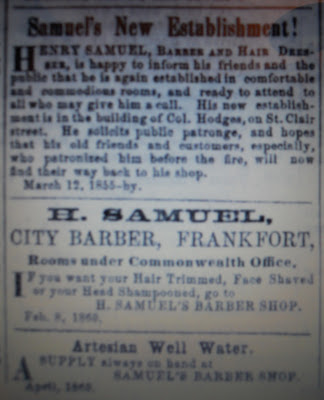Recently reading Knights of the Razor: Black Barbers in Slavery and Freedom got me to wondering if Frankfort had any black barbers in the antebellum era. Well, I didn't have to look too hard to find one. No, I didn't have to search through slides of microfilm searching the 1860 census records for Franklin County barbers - after all, in this particular case that would not have helped me.
Fortunately, I had remembered seeing an advertisement for a town barber while browsing through issues of the Frankfort Commonwealth newspaper some time back. And, it was not difficult to find these particular advertisements when I went back searching, because Henry Samuel had an ad in almost every edition of the newspaper for many years in the 1850s and 1860s. He must have been a firm believer in the old adage that "advertising pays." However, there was no clue from the advertisements whether he was African American or white. That part took some searching.
The three-section advertisement above was published in the August 19, 1862 edition of the Daily Commonwealth. The first part reads:
"Samuel's New Establishment! Henry Samuel, Barber and Hair Dresser, is happy to inform his friends and the public that he is again established in comfortable and commodious rooms, and ready to attend to all who may give him a call. His new establishment is in the building of Col. Hodges, on St. Clair street. He solicits public patronage, and hopes that his old friends and customers, especially who patronized him before the fire, will now find their way back to his shop." This part of the ad is dated March 17, 1855, and mentions the fire that burned his old shop and other buildings in 1854.
The second part of the ad reads: "H. SAMUEL, CITY BARBER, FRANKFORT, Rooms under Commonwealth Office. If you want your Hair Trimmed, Face Shaved or Head Shampooed, go to H. SAMUEL'S BARBER SHOP." This section is dated Feb. 9, 1860.
The third part reads: Artesian Well Water. A SUPPLY always on hand at SAMUEL'S BARBER SHOP," and is dated April 1860. Apparently he ran these ads so often the newspaper kept the type set for future uses.
 |
| "A Barbershop at Richmond, Virginia" |
A search for Samuel in the 1860 census found him listed as a 37 year old black man. Interestingly, the 1860 census did not list his occupation or his personal property or real estate worth. He was living with his wife Mary, who was 33 years old and identified as a mulatto. Also listed are his daughter Maria (15, mulatto), son Thomas (13, mulatto), a Alfred Hardin (17, mulatto) and a Minerva Wilkerson (60, mulatto), who may have been - I guessed - Samuel's mother-in-law, but I'm certainly not positive.
Henry Samuel is listed, too, in the 1850 census. Here he is shown as a 30 year old black man and his occupation is designated as a barber. Intriguingly, Mary, Maria, and Thomas are all listed as black, unlike the 1860 census census, which described them as mulatto. Also, listed in the family is a one-year-old with the unique name Barber Samuel. The infant Barber must not have survived childhood since he was not listed in 1860. Included in the household was 18 year old mulatto John Burbridge, who is also listed as a barber, and was likely an apprentice to Henry Samuel in his shop. Lastly is listed 68 year old Rosanna Hickman. Like Minerva Wilkerson in the 1860 census, I'm not certain who this extended family member might be.
Henry Samuel was found in the 1840 census also. There, he is listed as a single free man of color.
Henry Samuel must have benefited greatly from locating his shop where he did. Being in the office of one of the town's most distinguished newspapers, where politicians surely came to get the latest information - and within a block of the State Capitol building - must have put him in contact with many of the state's most wealthy and powerful men of that era. Certainly many were his customers.
As Samuel's advertisement indicates he was on the ground floor "under the Commonwealth Office" on St. Clair Street. The above image shows the old Frankfort Commonwealth newspaper building in the late-nineteenth or early- twentieth century when it served as the Stehlin furniture store.
The same building is shown above as it appears today. It was most recently the Marcus furniture store. The owner of the store bricked in the windows and painted the brick to look like window openings.
It is amazing to think that 150 years ago a walk by this location would have probably brought one into company with Kentucky's most influential individuals. The political strategy discussions that probably occurred in Henry Samuel's barbershop as the nation moved toward Civil War and as Kentucky weighed its considerations must have been thrilling. Additionally, the inside information that Samuel must have overheard and carried back to his African American friends and neighbors surely provided some advantages that most other slaves and free blacks simply did not have.
George H. Stehlin Building image courtesy of Russ Hatter and the Capital City Museum.










The Windows to be restored back to original would of cost an outrages amount. So Samuel and Elliott got with artist Simon Finnell ( Me ) and came up with painting the Windows back on the wall. another way of keeping art alive in frankfort.
ReplyDelete